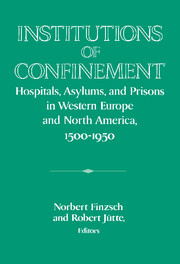 Institutions of Confinement
Institutions of Confinement Published online by Cambridge University Press: 05 January 2013
Because the very notion of a dangerous class is the product of the fears of city dwellers, the dangerous class has changed as the fears of city dwellers have changed. The question of how definitions of “the dangerous class” change over time is a crucial element of this current study. The issue of who were adjudged to be dangerous had also become a part of a larger historiographic debate on the origin and evolution of vagrancy laws. Chambliss set forth the original analysis of vagrancy laws in a 1964 article arguing the economic origins of vagrancy laws in early England and asserting that “control of criminals and undesirables was the raison d'être of the vagrancy law in the U.S.” Seeing the purpose of vagrancy laws in primarily economic terms, Chambliss proposed an analysis in class-based terms which he felt “demonstrated the importance of Vested interest' groups in the emergence and/or alterations of laws.”
Chambliss's strictly economic view has been challenged by Adler's recent articles. Beginning with the observation that “vagrancy statutes and their applications have changed frequently and dramatically,” Adler uses vagrancy laws to test the validity of a broadly Marxist view of criminology which asserts “the class-based explanations for the character of legal institutions.”
To save this book to your Kindle, first ensure [email protected] is added to your Approved Personal Document E-mail List under your Personal Document Settings on the Manage Your Content and Devices page of your Amazon account. Then enter the ‘name’ part of your Kindle email address below. Find out more about saving to your Kindle.
Note you can select to save to either the @free.kindle.com or @kindle.com variations. ‘@free.kindle.com’ emails are free but can only be saved to your device when it is connected to wi-fi. ‘@kindle.com’ emails can be delivered even when you are not connected to wi-fi, but note that service fees apply.
Find out more about the Kindle Personal Document Service.
To save content items to your account, please confirm that you agree to abide by our usage policies. If this is the first time you use this feature, you will be asked to authorise Cambridge Core to connect with your account. Find out more about saving content to Dropbox.
To save content items to your account, please confirm that you agree to abide by our usage policies. If this is the first time you use this feature, you will be asked to authorise Cambridge Core to connect with your account. Find out more about saving content to Google Drive.